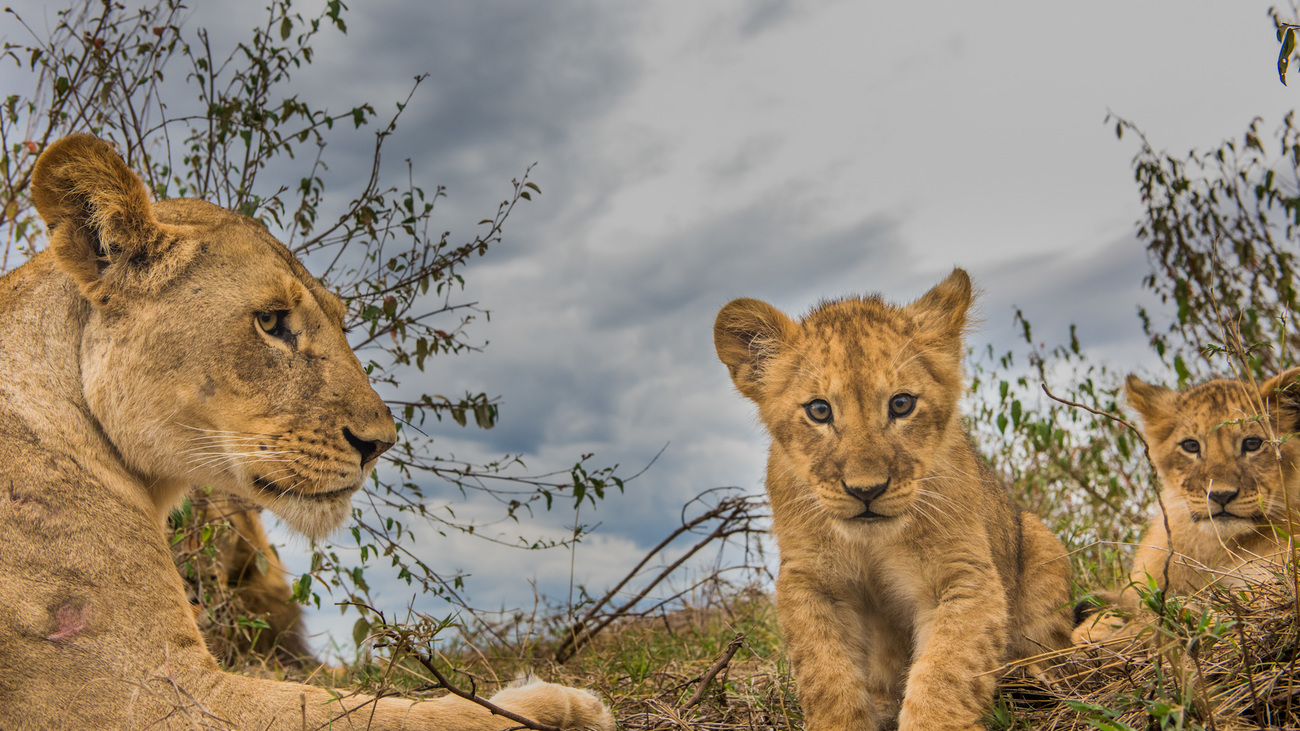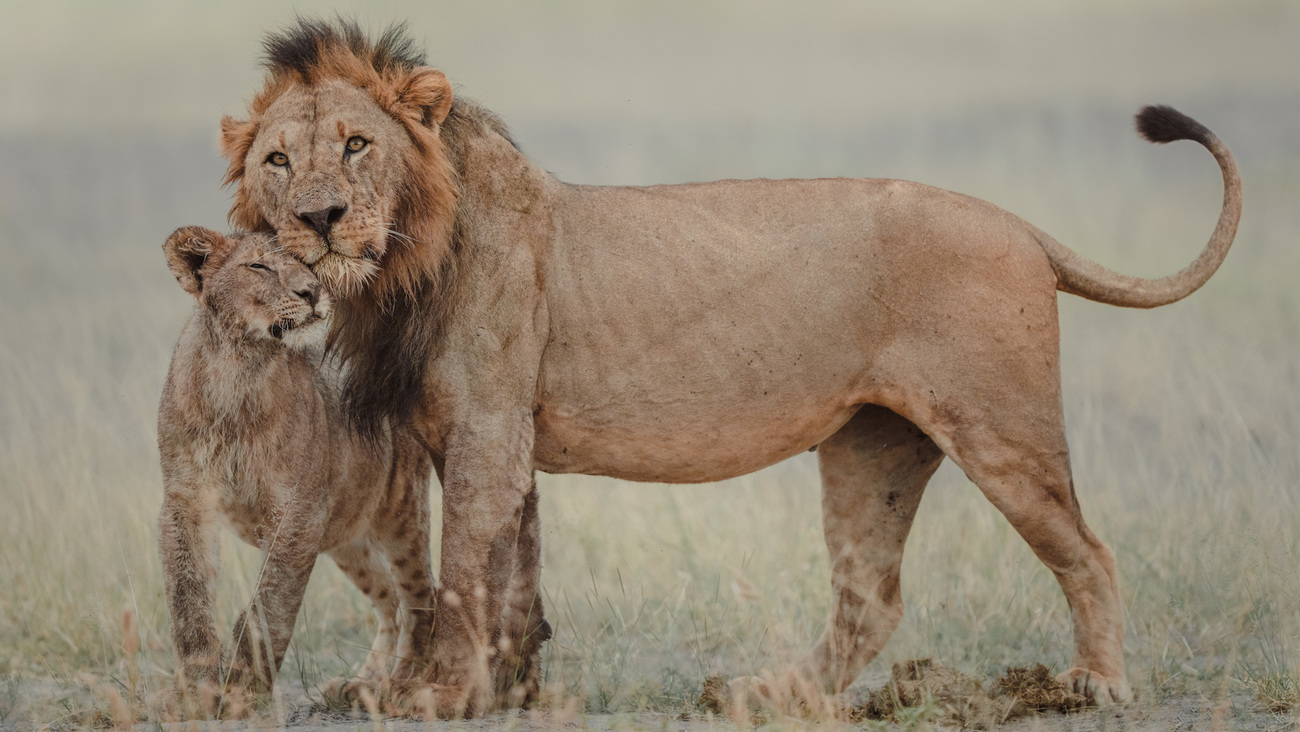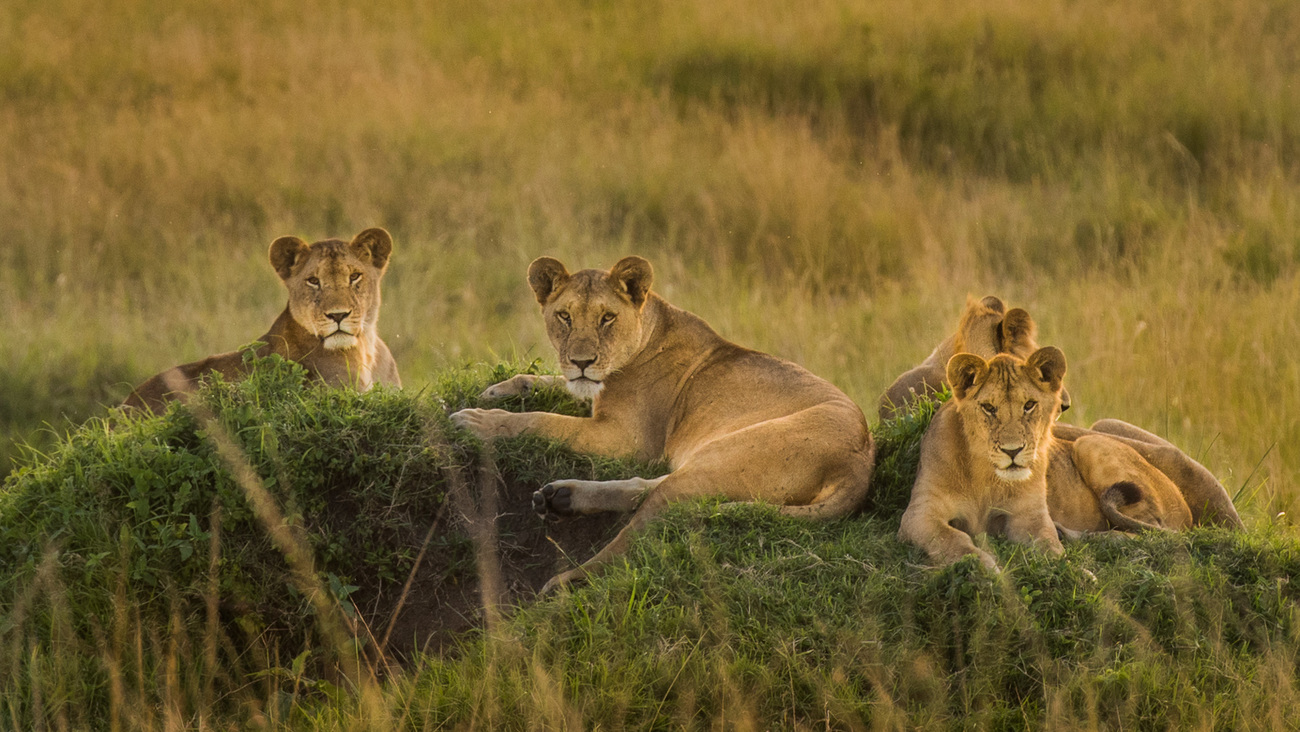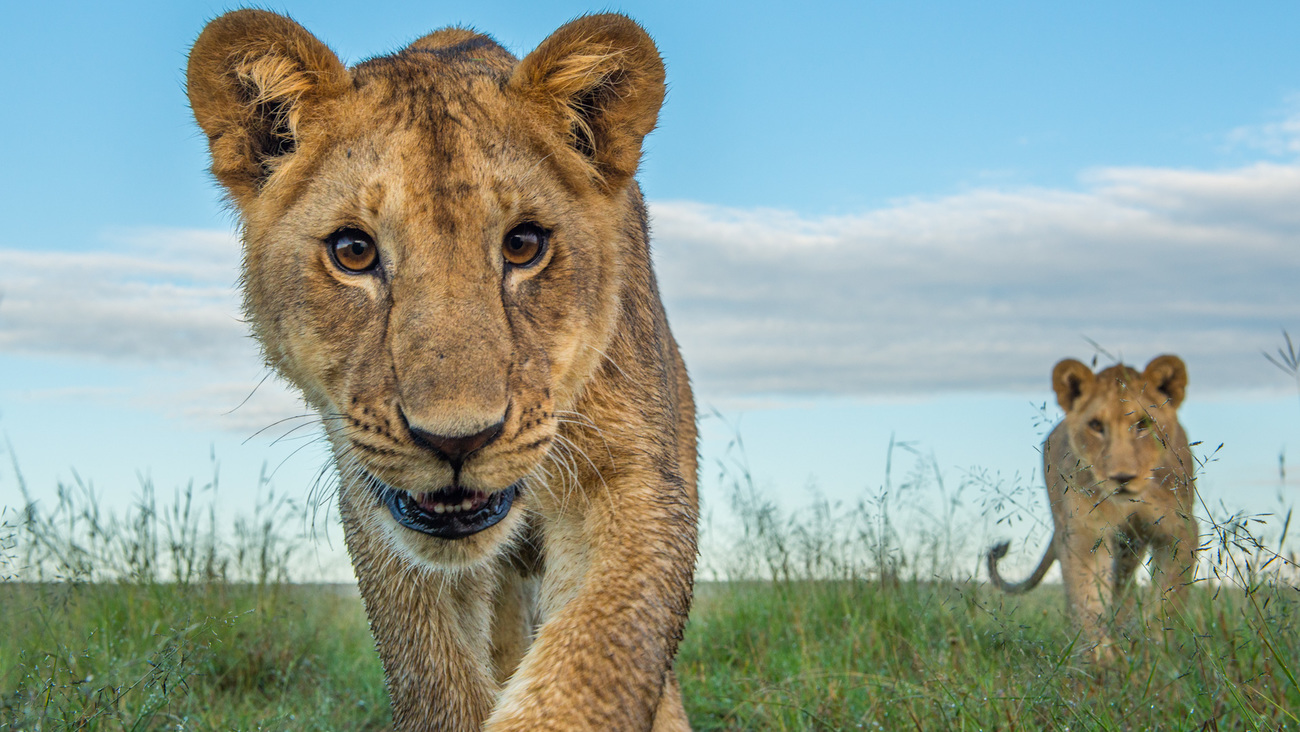Lions
Lions are big cats primarily found in sub-Saharan Africa. They inhabit various ecosystems, including savannahs, grasslands, open woodlands, and scrublands. In addition to African lions, there is also a small, isolated population of Asiatic lions inhabiting India’s Gir National Park.
Adult males typically weigh 120 to 190 kilograms (260 to 420 pounds) and stand about 1.2 to 1.4 meters (4 to 4.5 feet) tall at the shoulder, while adult females are slightly smaller. Lions have a tawny-colored coat with a tufted tail, and males often have manes of varying coloration, from blonde to dark brown or black. Female lions, called lionesses, lack manes.
These big cats are carnivorous predators and primarily prey on smaller mammals, including zebras, wildebeests, and buffalo. They are opportunistic hunters, so they will also eat smaller prey like impalas and warthogs or scavenge meat from the carcasses of dead animals.
Lions are skilled hunters who work in coordinated groups—called prides—to surround and ambush their prey. The lionesses do most of the hunting, relying on stealth and speed to approach their target before launching a coordinated attack. Males sometimes join in for the hunt but are usually more involved in defending their territory and pride.
As highly social animals, lions live in prides composed of related females, their cubs, and a coalition of males. Female lions give birth to a litter of cubs after a gestation period of about four months. Typically, a lioness gives birth to two to six cubs per litter in a sheltered den. These cubs are then raised collectively within the pride, with several lionesses often nursing and caring for them.
Lions play a crucial role in their ecosystems, and their presence has several important ecological and environmental benefits. Firstly, they help control the populations of herbivorous animals, like zebras and wildebeests, preventing overgrazing and ecosystem degradation. By controlling herbivore populations, lions also indirectly influence vegetation patterns and the overall health of their ecosystems. This, in turn, impacts other species, such as birds and small mammals, that depend on diverse habitats for survival.
Healthy and balanced ecosystems, maintained by lions and other top predators, also play a role in sequestering carbon and mitigating climate change by preserving vegetation and the carbon it contains.
Lions are also a significant attraction for ecotourism, generating revenue for local communities and countries. When done ethically and sustainably, in a way that does not negatively impact animal populations, this income can support conservation efforts, provide jobs, and contribute to the overall economy.
What is a lion’s scientific name?
The lion’s scientific name is Panthera leo. The genus name Panthera is of Greek origin and includes all big cats—tigers, lions, jaguars, and leopards—while leo is the Latin word for lion. Lions are part of the family Felidae, colloquially called cats.
Are lions endangered?
Lions have been classified by the IUCN as vulnerable since 1996. The Asiatic subspecies has been classified as endangered since 1986.
The lion population is declining and has experienced a reduction of approximately 43% over the past 21 years due to habitat loss, human-wildlife conflict, and poaching.
Where do lions live?
African lions are found in a range of habitats across sub-Saharan Africa, including savannahs, grasslands, open woodlands, and scrublands. While they can adapt to a variety of ecosystems, they are most commonly found in the African savannah. There is also a small, secluded population of around 650 Asiatic lions in India’s Gir National Park on the Kathiawar Peninsula.
Lions once roamed across all of North America and Africa, through most of the Balkans, and across Anatolia and the Middle East into India. However, their populations disappeared from North America around 10,000 years ago, from the Balkans about 2,000 years ago, and from the Middle East over 900 years ago. Today, their numbers are estimated to have dwindled to between 23,000 and 39,000. Lions living outside of national parks are rapidly losing their habitats to agriculture.
Threats
Lions face several significant threats to their survival. They are hunted by poachers for illegal trade and by hobbyists for sport. Habitat loss, decline in prey species, and other human activities also significantly impact lion populations across Africa.

Poaching and trophy hunting
Lions are targeted by poachers for their body parts—including their bones, teeth, and claws—which are highly valued in traditional medicine and the illegal wildlife trade.
While international trade in lion products is regulated, illegal markets persist, posing a serious threat to lion populations. Lions are also hunted as trophies, along with other big game animals in reserves across the African continent.
Habitat loss
Lion habitats are being lost and fragmented by expanding agriculture, urbanization, and infrastructure development. As human populations grow, so does the demand for land, resulting in the conversion of lion habitats into croplands, pastures, and settlements. This fragmentation isolates lion populations, making it more challenging for them to find mates and maintain genetic diversity.
Decline in prey species
The decline of the lion’s natural prey species, such as zebras, wildebeests, and antelopes, poses another significant threat to their survival. As their prey is increasingly hunted for commercial bushmeat trade, there is less available for lions. The IUCN estimates these prey species populations have declined by as much as 52% in East Africa and 85% in West Africa.
As a result, lions may turn to livestock for food, leading to conflicts with local communities. This leads to the next main threat faced by lions—human-wildlife conflict.
Human-wildlife conflict
As communities encroach on lion territories, conflicts between people and lions escalate.
When a lion preys on livestock, damages property, or threatens a human life, ranchers may kill the lion in retaliation or as a preventative measure, sometimes using pesticides as poison.
Efforts to protect lions and their habitats involve a combination of conservation strategies, including anti-poaching measures, habitat preservation, community-based conservation initiatives, and human-wildlife conflict resolution programs. We need to not only protect the lions and their habitats but also promote peaceful co-existence between lions and people.
FAQs
Let’s learn more about these big cats with some interesting lion facts.
What do lions look like?
Lions are large, muscular big cats with tawny coats that help them blend into their grassland habitats. Adult male lions often have a prominent mane of hair around their neck and head, varying in color from blond to dark brown or black.
Their faces feature white markings and a black outline around their eyes and noses. Lions have sharp, retractable claws and a tufted tail. They are about 1.2 meters (4 feet) tall at their shoulders.

Are lions cats?
Lions are big cats. They belong to the family Felidae, which includes all modern cat species. Their genus, Panthera, also includes leopards, jaguars, and tigers.
What do lions eat?
Lions primarily eat a diet of meat, and their main prey includes large mammals such as zebras, wildebeests, buffaloes, and various types of antelope. They are known to consume smaller mammals when larger prey is scarce, and they may also scavenge carcasses.
Lionesses are the primary hunters, using teamwork to encircle and ambush their prey, while male lions act as lookouts and protectors. After a successful hunt, there is a feeding hierarchy within the pride, with lionesses and cubs eating first, followed by dominant males, and then the rest of the pride members.
Do lions eat hyenas?
No, lions and hyenas are both top predators and consequently don’t hunt each other. However, as opportunistic scavengers, lions are known to steal hyenas’ hunts, if the chance arises.
Though it’s not common, hyenas are known to occasionally attack lions in the wild as a way to protect themselves and their hunts. Hyenas are an intelligent, adaptable species and can work together to take down a lion they see as a threat.
Do lions live in the jungle?
Contrary to popular belief—and the nickname ‘king of the jungle’—lions don’t actually live in the jungle. They are most comfortable in the savannahs and grasslands of sub-Saharan Africa.
How long do lions live?
In the wild, lions live for an average of 12 years and up to 16 years. In captivity, lions can live up to 25 years.
What does a lion’s mane do?
Lions’ manes aren’t just for show. They also play a role in signaling a lion’s health and dominance to potential rivals and mates. Long, dark manes signify that the lion is in peak health and therefore makes the lion more attractive to females.
Manes also protect lions by shielding their necks and throats from bites and scratches, and they offer shade from the heat of the sun.
What is a group of lions called?
A group of lions is called a pride. The average pride is made up of 15 lions, but its size can range from as few as four to as many as 37.

How much does a lion weigh?
Adult male lions weigh 120 to 190 kilograms (260 to 420 pounds), while adult female lions are slightly smaller.
How big is a lion?
Lions stand between 1.2 and 1.4 meters (4 to 4.5 feet) tall at the shoulder, and their body length, excluding the tail, ranges from 1.5 to 2.5 meters (5 to 8 feet). These measurements can vary depending on the lion’s age, sex, and overall health.
Are tigers bigger than lions?
Yes, tigers are bigger than lions. Tigers are the largest of the big cat species.
How fast can a lion run?
Lions can run very fast when needed, at speeds of up to 81 kilometers per hour (50 miles per hour). However, they can only run this fast for short bursts, typically when chasing down prey during a hunt.
Do lions purr?
Unlike domestic cats, lions lack the physiological structure to create a purr in their throats. However, they can produce other vocalizations, including grunts, growls, and roars. These noises serve various communication purposes within the pride, such as maintaining social bonds and signaling territory.
Can a lion climb trees?
Though domestic cats love to climb trees, normally lions will only do so when threatened. However, there is a unique pride of lions in Queen Elizabeth National Park, Uganda, which can—and do—regularly climb trees.
It’s a great way to stay out of reach of prey, to get a good vantage point of the surroundings, and stay cool in a hot and humid climate.
Can a lion swim?
Technically, yes, lions can swim, but they rarely do. The only times you’ll see them submerging themselves in water is when they are crossing rivers.
Do lions eat humans?
As wild animals, lions have been known to attack and eat humans. There have been several cases of lions in Tanzania eating humans. As human populations increase and begin to take over lion habitats, conflicts between humans and lions will inevitably arise—and often don’t end well for either party.
Are lions endangered?
Lions are classified as vulnerable by the IUCN, but the small Asiatic lion population is considered endangered. Lions face many threats to their survival as a species, including poaching, habitat loss, decline in potential prey, and human-wildlife conflicts.
How many lions are left in the world?
The IUCN estimates that between 23,000 and 39,000 mature adult lions remain in the wild. In Asia, there are only about 650 lions remaining, all of which live in India’s Gir National Park.
Our work
IFAW is working hard with organizations across the globe to help conserve and protect animal species that are under threat, including lions.
Working in partnership with the Uganda Wildlife Authority, IFAW supported the training of volunteers who work to protect lions in Uganda that are constantly under threat from poachers and game hunters.
Moses Olinga, IFAW’s program manager for Uganda and the Horn of Africa, stated, ‘The volunteers are key in disrupting poaching and trafficking because the people involved in wildlife crime stay in their communities, so volunteers can give accurate information.’
In Queen Elizabeth National Park, the Ishasha lions, a unique group of 35 lions, climb and live in trees—a behavior seen nowhere else. To protect these lions and the prey species on which they rely, IFAW has partnered with multiple conservation organizations to combat cross-border wildlife trade between the two countries.
Rangers move through the park on patrol, identifying and neutralizing traps set by poachers. Along with other organizations, IFAW supports rangers with the skills and tools needed to protect endangered wildlife like Ishasha lions, pangolins, and elephants.
IFAW worked tirelessly to get the Big Cat Public Safety Act passed into legislation, which was finally approved by the Senate in late 2022. It’s a measure that prohibits the private ownership of tigers, lions, leopards, and other big cats as ‘pets’ while also restricting dangerous contact between the public and these cats.
During the conflict in Ukraine, IFAW has been supporting local wildlife rescue centers with food and veterinary care for and the evacuation and transportation of big cats. Many big cats, including lions, were purchased as pets, and as they grew older, the owners no longer wanted them. The animals were then left behind when families had to evacuate because of the war or were surrendered anonymously to avoid potential prosecution. In other cases, big cats were rescued from breeding facilities where they were unable or unwilling to continue to care for the big cats as resources became scarce. It is believed that there are many more big cats (mostly lions) in private homes in need of rescue within the country. We continue to work with local partners to assist them in rescuing and evacuating big cats in need in Ukraine regardless of their age and location, whenever it is both legal and safe for human rescuers.
How can you help?
Lions help prevent overgrazing, influence vegetation patterns, and maintain the overall health of the ecosystems on which they—and so many other animal species—depend. Supporting conservation efforts to protect lions benefits animals, people, and the planet.
